It’s easy to treat copywriting as an afterthought in B2B marketing. If people need a product, they’ll find it. And if your product is good, they’ll buy yours. Right?
If only.
Everyone has a basic grasp of language. If you also have strong knowledge of your product, the assumption is that you should be able to clearly convey its benefits in a way that your audience will care about. Unfortunately, it’s not quite that simple. The end result is a lot of marketing copy that just fills space but doesn’t convert. In an increasingly crowded marketplace, this just creates noise. And that’s a cue for prospective customers to disengage.
‘Copy’ refers to any text written for a promotional purpose. This could be a tagline on a billboard, an email to subscribers, a video script for an ad campaign, or simply the text that appears on your website.
Copywriting comes with a bunch of subtle rules and best practices that differentiate it from everyday communication. But a few key questions should keep you on the right track:
Let’s unpack what good copywriting actually looks like. Here’s your crash course to improve the effectiveness of your marketing campaigns in an instant.
Contents:
B2B is ‘business-to-business’ – referring to industries that create products primarily for business use. For example, things like accounting software, office furniture, or freight management.
B2C, in contrast, is ‘business-to-consumer’, which accounts for pretty much everything else used by individuals in their day-to-day lives. Products like food, alcohol, clothing and so on.
The common perception is that the tone of voice for B2C marketing is more relaxed and ‘fun’. Whereas B2B is more formal and ‘boring’ by nature. There’s an element of truth to this. For example, beer branding will often aim to simply create a vibe. Maybe it’ll also convey product features like low carbs or alcohol content. But mostly it’s about conveying a sense of sociability and relaxation that consumers can project themselves into.
B2B brands typically have a few more hoops that need to be jumped through, with more technical product offerings that need to be explained. This complexity can potentially weigh down the copy from a ‘vibes’ perspective. This means B2B copywriting tends to require more research to understand audience personas, including motivations and pain points.
B2B purchase decisions also tend to take longer, due to there being more stakeholders involved, along with the need for budget approvals and so on. The role of copy in nurturing leads and justifying the business case therefore takes on added significance.
A few things worth noting: In B2B marketing, your audiences are still people. Even if they have a business agenda, the same principles apply for engaging them. Copy still needs to be concise and attention-grabbing. If anything, you need to be aware that you’re not just winning the attention of individual consumers. You also need to convey a clear business case that they can take to other stakeholders within their business.
Will your product save money for businesses? If so, how? And how much? Will your product save them time or complexity so they can put more resources towards other tasks? And so on.
When it comes to digital copy, it’s as much to do with navigation as it is about persuasion.
Good copywriting – much like design – is ultimately a means of wayfinding for customers. It acknowledges a consumer need, contextualises the value of the solution, and guides them intuitively towards the next step.
Let’s take another look at those questions I mentioned earlier.
Good copywriting understands the needs, wants, and challenges of its audience. Obviously, you can’t talk to everyone at once. Your content needs to be targeted, without becoming so niche that it becomes irrelevant or too niche for people to engage with.
For any piece of content you create, you should have a clear idea of which audience segment you’re targeting. It could be a general audience. It could be for people who work in a certain industry or a certain job type. Or it could be for people who live in a particular region. Their common signifiers will dictate how you speak to them.
A very simple example: If you’re creating organic content for your social media channels, this will primarily be seen by people who already follow your account. That means they’re more likely to be familiar with your brand and have an active interest in your products. If you’re creating sponsored content to run as ads, this will appear in front of a less invested audience, so this content may need to be pitched at a different level. And if you want content to be shareable, it needs to be entertaining and/or informative, rather than salesy.
Audiences have different expectations in different settings. They engage with content in different ways. For example, right now you’re reading a blog post on TMP’s website. That suggests you have an interest in this topic and are willing to engage with long-form content (or skim it at the very least). The purpose and value of this medium is to provide a relatively deep dive into a particular topic.
If you were reading an email newsletter from TMP, however, you might not be actively engaged in this topic, so you might only get a bite-sized blurb to see if you wanted to click through and read more without wasting your time in the body of that email.
On social media, no one wants to read a long caption, so get your point across concisely. Whether you’re posting an image or a video, the visual asset should do the heavy lifting in terms of engagement, while the caption should only be used to complement that hook with a CTA and/or value-adding context.
Even if you’re focusing on primarily visual mediums, copy still has an important role to play. Arguably even more so, because less copy means it has to work harder. For example, videos tend to auto-play silently on social media by default. Strategic copy – subtitles aside – could be what gets someone to turn up the sound and engage with the content. This could be a tantalising question or headline posed at the start of the video.
That said, copy in videos should be minimal. If someone is speaking, or you’ve recorded a voiceover, the copy within the video should align closely with what the speaker is saying, and only used sparingly to emphasise key points.
If it’s a paid ad, copy carries even more responsibility to earn engagement, because it’s not something that users are actively following. You probably only have a couple of seconds – tops – to make someone care about your brand in a sponsored ad placement. You need to find the most attention-grabbing angle to present your product.
Typically, the structure of any content creation will be:
The trick is to make it feel seamless and authentic, in order to tap into prospects’ needs and wants. It’s a balancing act. If you get too specific, you narrow the audience that you’re speaking to. If you’re too generic, it’s less likely to engage.
Often, brands fall into the trap of trying to act like they know everything about you. But it’s easy to miss the mark with copy that comes across as forced or insincere.
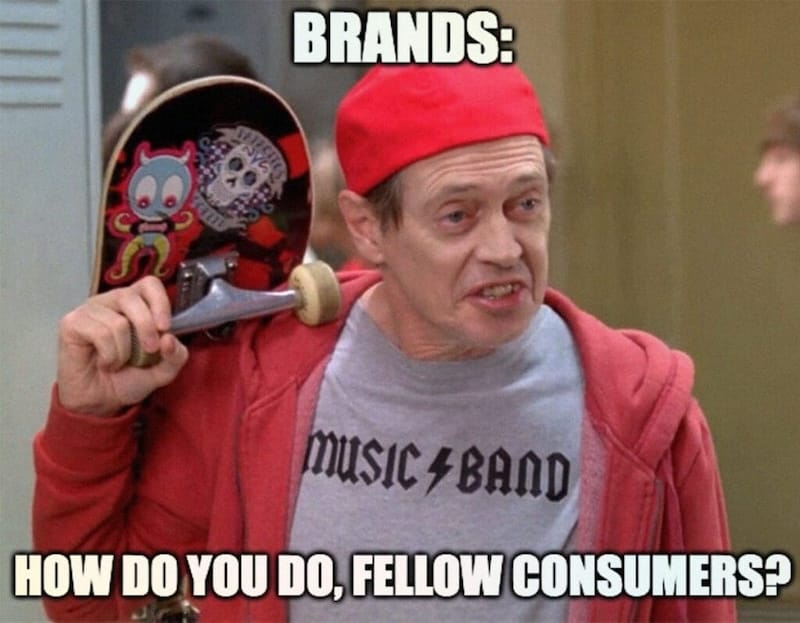
Ultimately, regardless of the channel or depth of your content, this basic structure will be present. The problem sets the context of a challenge that your audience will recognise. The solution sets up your product as the most effective way to address the problem. The CTA gives them a clear next step towards that solution – whether it’s to learn more, make contact with your team, or to make an actual purchase.
There are a few ways to earn attention, including:
Copy doesn’t exist in a vacuum. It’s an extension of your brand. Tone of voice should remain pretty consistent across all the material you produce. Firstly, this creates a stronger sense of brand identity that’s likely to foster more trust and authority as you nurture leads through the marketing funnel. Secondly, this consistency ensures your copy remains aligned to your product and audience expectations.
We’ve all seen big brands trying to be funny or sassy on social media. Or ‘fun’ brands trying to post solemn tributes in the wake of tragic events. The risk/reward ratio isn’t favourable. Brands shouldn’t try to be all things to all people. You don’t need to weigh in on things outside your industry or area of expertise. Stay in your lane and you should be fine.
What’s the point of getting someone’s attention if you don’t give them a clear path to follow?
If you’re trying to convince people to buy your product, create a path for them to do that. If you want them to subscribe to a mailing list, or contact your team, give them the most direct path to do so. Users will inevitably drop off at every step, so the fewer clicks and scrolling required the better. Your call to action should always promise value, and the destination that a CTA button takes users to should reward that click with what they expect to see.
Similarly, too many CTAs on one page can disorient users and not
Sounds simple. But it’s amazing how often this stage of the user journey becomes an obstacle.
It’s easy to fall into bad habits, especially when timelines are tight and resources are limited. Here’s a checklist of common copywriting traps to try and avoid.
❌ Too wordy.
A common mistake in copywriting is to make the text too dense. Trying to say too many things or elevate the tone in an attempt to sound formal. Brevity is important, but so too is rhythm.
Copy isn’t about trying to sound as clever as possible. It’s about being understood and getting to the point. The aim of the game is to create a path between consumer needs and their desired action as concisely as possible. Problem — Solution — Call to action.
❌ Too much hard selling.
Not everyone in your audience is coming in at the same level of knowledge. Some may already be familiar with your brand and product offering. Some may have even made purchases with you previously. Others may be vaguely aware of your brand, while some won’t have heard of you before. You can’t hard sell to everyone.
❌ Ignoring what your audience cares about.
Perhaps the most frequent mistake that brands make is getting too caught up in what they want to say, rather than what their audience wants to hear. Don’t drown them in detail. Be concise. Stay solution-oriented. Speak to their specific pain points. And give them a clear path to take the next desired action.
❌ Incongruous call to action.
Speaking of desired actions, conversion doesn’t always mean a sale. Ultimately, yes, you want people to purchase your product. But there are other objectives that may be more effective along the way.
For example, effective copy might encourage users to ‘learn more’, ‘subscribe’, ‘get a free trial’, or ‘schedule a call’. B2B sales require trust and lead nurturing to increase conversions and encourage repeat business.
❌ Let down by poor UX.
Just as an unappealing headline, or hard-selling CTA might be a cue for disengagement, user experience is just as important. When a user clicks through to a page that doesn’t make sense to them at first glance, they’ll instantly drop off. Good copy is aware of the next steps of the user journey to ensure user expectations are managed and rewarded with every click.
Someone once told me that good copy should act like gravity. Gently pulling prospects down a page — so compelled by their own desires or curiosity that they don’t even notice an external force being exerted. To think about it another way, your copy and user journey is like open-plan architecture, allowing leads to flow effortlessly from room to room.
Here are some tips for more effective copywriting.
✅ Get to the point.
The golden rule for all writing, really. Marketing is interruptive, so don’t waste your audience’s time. Give them solutions. And remember, it’s better to be clear than clever.
✅ Be benefit-driven.
A lot of brands get caught up in what they want to say, rather than what their audience wants to hear. Start with your audience’s needs and work backwards.
✅ Don’t forget the business case.
B2B sales involve multiple stakeholders. You’re not selling to individuals re: ‘ease of use’, you’re
building a ready-made business case for senior decision-makers (e.g. ‘save time & money’).
✅ Clear CTAs & conversion path.
It’s no use winning someone over with a compelling ad if users can’t follow an intuitive path to purchase and/or find out more. CTAs should reflect the copy that comes before it. And the next step in the navigation path should affirm a user’s choice to click.
For example, if you send out an email spruiking price points and discounts on certain products, your CTA should be along the lines of ‘Buy Now’, and clicking that button should take users to a product page where they can directly make an order. If content aims to pique audience curiosity or likely to prompt follow-up questions, a more suitable CTA would be something like ‘Learn More’ or ‘Get In Touch’.
Finally, it’s worth noting that there’s never one definitive answer when it comes to copy. Different hooks or CTAs may be equally effective. While a lot of strategic insight takes place before creating content, that research process doesn’t end when you publish something. Digital copy is a living, breathing thing that you should continue to test and refine to see what resonates best with your audience.
Be sure to check our additional resource on content creation to further enhance your approach.
Ever spent a bunch of time and budget refreshing your logo and brand platform, only to dread how soon you might need to update it all again?
It’s the inevitable cycle of marketing: Businesses trapped in an infinite loop of building, consolidating, and refreshing their brand.
How much capital is there in consistent branding? What’s the lifespan of design trends? How do you know if branding will continue to resonate as your audience grows? And how do you know when it’s time to burn it all down and start again?
Contents:
How does graphic design shape branding?
Should you follow industry trends?
What does a successful rebrand look like?
How to use design trends to your advantage
Trends are a funny thing. Whether you’re talking about fashion, music, or graphic design, trends come and go frequently. This can be driven by a range of nebulous factors, like the whims of prominent tastemakers, critical mass of widespread adoption, or the natural cycle of trend revival.
But this poses a dilemma: Should you devote yourself to constant reinvention as dictated by passing fads? Or ignore them and risk being left behind?
In marketing, there’s also an extra layer to consider in terms of the capital built up over time from consistent, recognisable branding. If you hear ‘golden arches’, for example, pretty much everyone knows what brand that refers to. And you can bet that kids will instantly spot the red and yellow sign cresting over the horizon on a long car trip.
Graphic design trends communicate via the common visual language of the time. It acts as a kind of shorthand for effective storytelling that speaks to evolving consumer interests. The flipside, however, is that it can risk coming across as inauthentic or muddy the waters when it comes to brand consistency.
So, what to do? What are design trends worth? Is it even worth being trendy? And how do you evolve a brand without losing what you’ve built?
Whether we like it or not, every piece of brand output — from logos, to typography, to colour palettes, to tone of voice — exists relative to the public’s general perception of trends.
A lot of graphic design is underpinned by deep symbolism and lengthy rationales around why a certain line is at a certain angle in a corporate logo. From an audience perspective, where people aren’t obliged to pay attention to anything beyond their own convenience, the end product largely boils down to ‘vibes’.
Visual branding is littered with clever touches that most casual observers won’t even notice on first glance. Like the arrow hidden in the FedEx logo. Or that the ‘smiley face’ arrow in the Amazon logo goes from ‘A’ to ‘Z’ (while also ignoring that there’s a whole other ‘A’ right next to the Z).
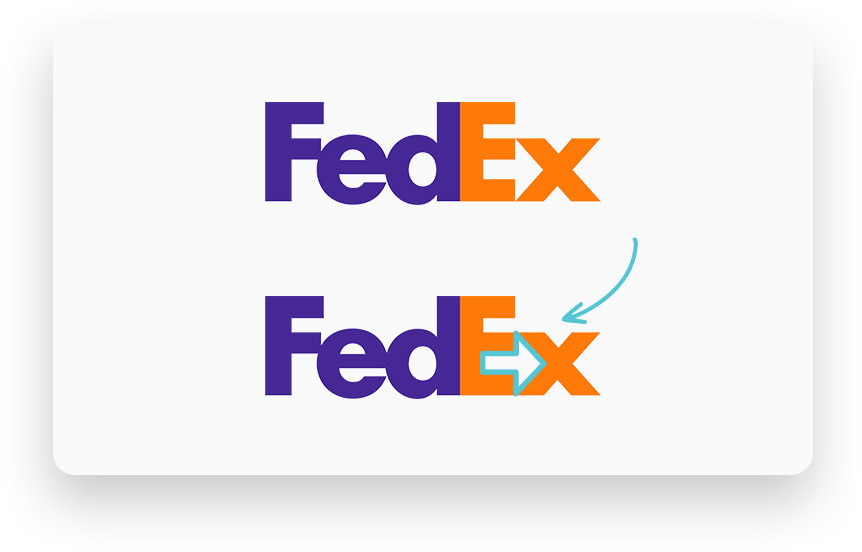
These elements tie together to create something cohesive and memorable. The audience might not always know why it works, but it does. And it’s thanks to the attention to detail applied by designers.
Consider another example. One of the simplest, most recognisable logos: the Nike swoosh. Like the FedEx arrow, it points to the right — the direction our reading eye associates with progress. It also angles upwards, reflecting the positive reinforcement of a tick. It swoops around and tapers to convey dynamic motion — perhaps tracing the path of a tennis racquet, a golf club, or the arc of a leg as it kicks a ball. All of these micro signifiers align coherently with the brand identity. As an audience, this all flickers instantly in our subconscious. Nike = Sport. Sport = Nike.
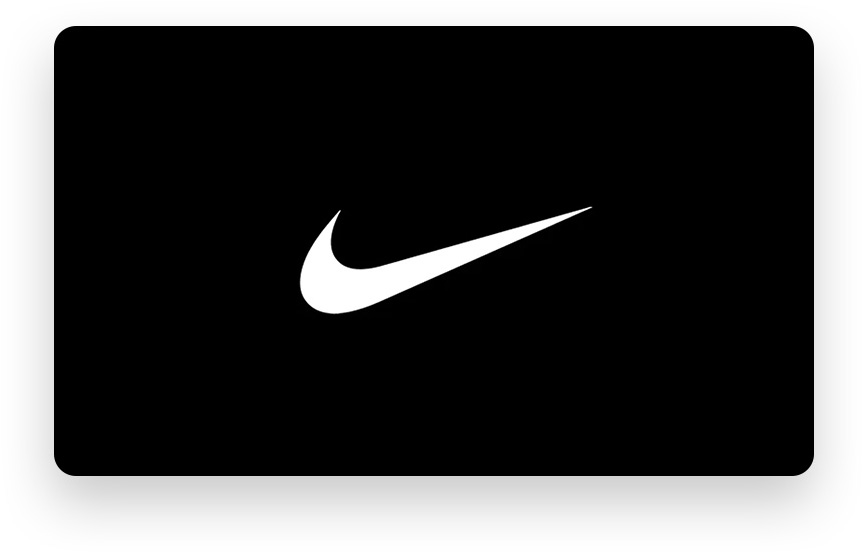
As trends become more widely adopted, they start to form a recognisable language. At the same time, perhaps that style starts to lose what made it striking in the first place. For example, tech companies have traditionally favoured the colour blue for its clean, understated aesthetic.
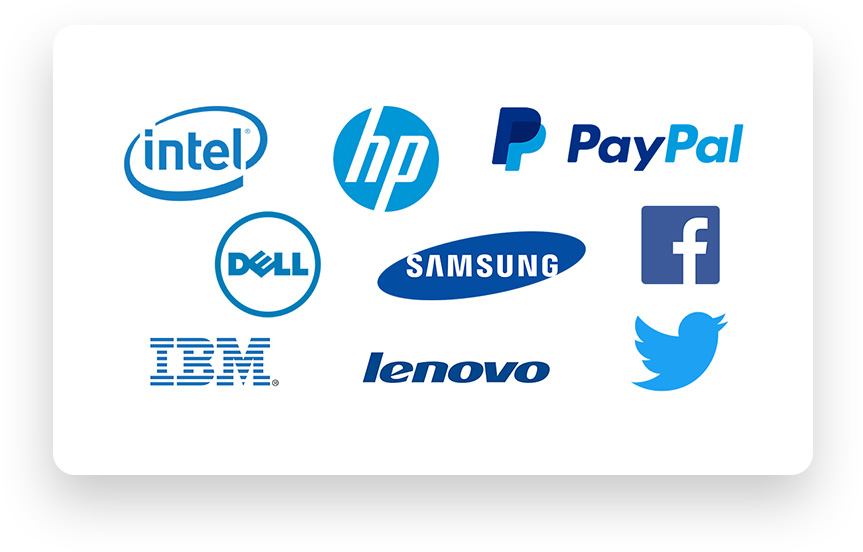
Some of these brands have existed for a long time (IBM’s blue logo has been in use since 1946), and aren’t seen as quite so cutting edge as they once were. More recently, Facebook has seemingly become a refuge for ‘boomers’ as younger generations have moved on to other social platforms. Suffice to say that this colour palette which once stood for innovation may now be more associated with legacy organisations. A quick look at popular apps probably reflects how tech and social media brands have since embraced a broader colour palette.
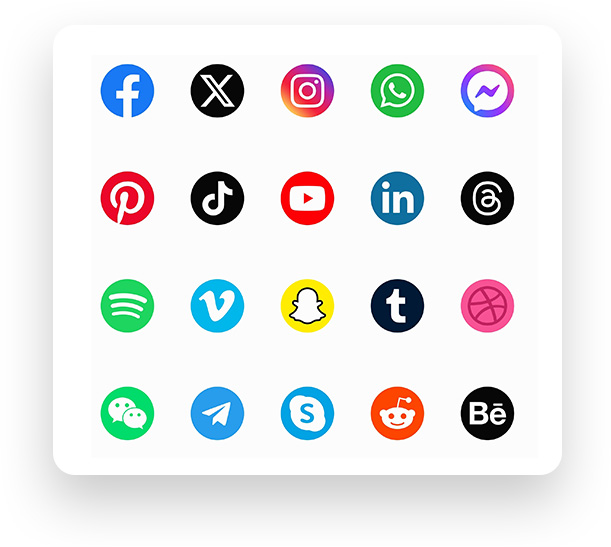
But it can get tricky. Trends are interwoven, and their presence is felt differently by different segments of your audience, depending on their demographic. The perfect font for a 45-year-old builder might be different from a younger architect’s tastes, even though these are both part of a supplier’s audience. That sentence in itself is a pretty absurd thought to consider. So brands often have to exist in the ‘in-between’ in order to balance tastes.
Trend saturation can also be a design hazard. The nature of trends can lead to competing brands all jumping on the same bandwagon — to the point that things which once stood out from the pack become ordinary, even stale.
With this in mind, there’s an argument for going your own way — forging your own cluster of signals, with a unique branding approach distinct from the rest of your industry. However, this approach still requires awareness and fluency in what’s being done elsewhere.
Doing your own thing comes with higher risk, but can command more interest. In the same way that whispering can be a powerful tool — provided you’re interested in what someone has to say. You lean in, pay closer attention. If you’re surrounded by a room full of people shouting, you’re more likely to seek out calmer, quieter energy.
Likewise, if a space is quiet, one person making a racket will stand out. Trends are a little bit the same. If everyone’s doing the same thing, there’s power in pivoting to a completely different approach. It commands greater intrigue. But you can’t stay unique forever without a willingness to adapt.
Trends will continue to be cyclical, however. Consider brands that are able to have it both ways. Coca Cola continues to market itself towards younger generations, while also appealing to nostalgia and periodically releasing old-fashioned bottle designs.
The red and white colour scheme is consistent. You can spot it from the end of the aisle in the supermarket whether it's a cardboard carton of cans or bottles in a fridge. The bottle silhouette remains recognisable. The font flourishes are still there. Coke can riff endlessly to keep things fresh while still holding onto its identity because the base elements of the brand are so iconic.
Of course, there are still natural parameters to consider. Overly sleek typography might match a brand’s aesthetic, but could become illegible in some settings. Firmly established brands like Coke can get away with more riffing and experimentation as they’re so recognisable. But, as a rule for newer or lesser known brands, any design choice that creates a potential barrier for audience engagement is probably not the right choice.
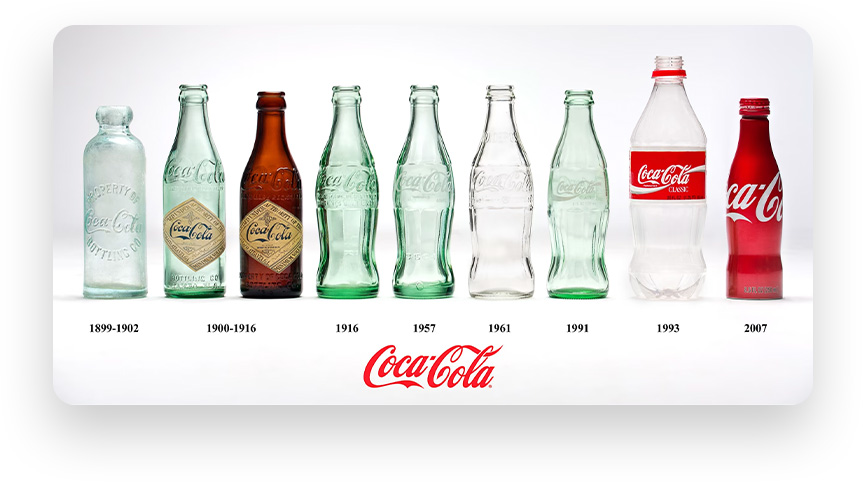
Logo design isn’t always an exact science. There are so many contributing factors. For starters, if your product isn’t compelling, there’s only so much that branding can do to garner attention.
Assuming you’ve got a strong product, your logo should be:
In recent times, there’s been a distinct movement towards minimalism in logo design. This is at least in part due to it being ‘fashionable’. It’s likely also an attempt by many companies to future-proof their branding to a degree — leaning into the ‘simple’ and ‘timeless’ criteria listed above. The less elaborate a logo is, the less likely it is to age quickly.
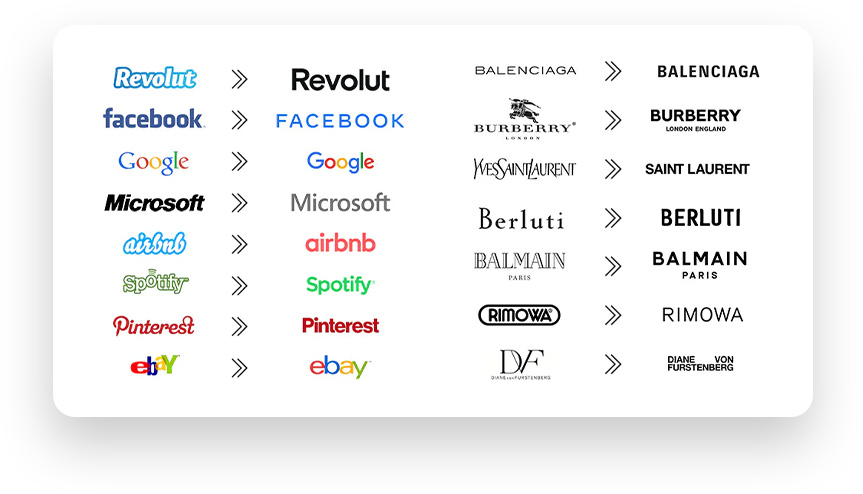
However, as wordmarks lurch towards the trendy homogeneity of sans serif fonts, the end result is a lot of brands starting to look the same. It’s worth noting that there’s a difference between simple and simplistic.
Are the new wordmarks easier to read? Probably. Are they interesting from a branding perspective? Not really. Viewed in isolation in their respective brand guidelines, it no doubt looks nice and clean. In a crowded landscape of very similar branding choices, it starts to feel a little soulless.
Fonts hanging out pic.twitter.com/rXUzNNlQp7
— Elle Cordova (@ellerhymes) January 23, 2024
Of course, there’s more to branding than logos and wordmarks, but these core graphics set the tone and often provide the basis of visual elements used across the board. There’s also arguably more emphasis placed on logos in the ‘app age’, where brands benefit from being instantly recognisable from a tiny thumbnail.
When rebranding, there are a few ways to go about it. Most brands opt for gradual evolution – refreshing their branding every now and then to keep up with the times and avoid looking dated. While some brands will opt for a hard reset.
One argument in favour of gradual evolution is to retain the capital built up over decades of brand recognition. There’s been a broader trend towards minimalism in corporate logos, prompting many to bemoan the increasingly widespread uniformity, in some senses this is a natural progression for legacy brands. The longer they exist and the more recognisable they become, the fewer visual cues the audience will need to recognise it. And if you can create a logo that’s recognisable without being a distraction, then it makes sense to use it. For a tech brand like Apple whose trademark is sleek, minimalist devices, the simple silhouette logo makes total sense.

In contrast, a brand like Red Rooster that aims to foster a warmer, family-friendly vibe with a little nostalgia thrown in. Minimalist design isn’t as natural a fit here. Having said that, you’ve got to hand it to the double-R chicken face of its latest iteration.

Ultimately, the job of a logo is the same as the job of copywriting — to say a lot with a little. So, in the case of Red Rooster, being able to create a tangible link to the product using only the company’s initials is *chef’s kiss*.
While the brands mentioned above are examples of evolution, what about the companies that burned it all down and started again? And what was their motivation for doing so?
The obvious recent example is that of Twitter becoming ‘X’. Of course, this was a captain’s call on the whim of new owner, Elon Musk. The shift has been jarring for many existing users, and continues to confuse people trying to find the app icon on their phones. The name Twitter and its iconic blue bird was both instantly recognisable and reflective of the platform’s purpose. In contrast, the X branding seemingly came out of nowhere, didn’t make much sense, and reflected a much colder, faux cool atmosphere. In some ways, the rebrand makes a kind of perverse sense, if only as a marker of a broader vibe shift.
Many long-time users have grown disillusioned with the app and claim the platform has changed for the worse during Musk’s tenure. From the controversial paid subscription model, to the increasing proliferation of bots and of alt-right propaganda — not to mention Musk’s own antics — the vibe has noticeably deteriorated. This is reflected in the drop in active users since Musk’s acquisition in October 2022. For many of the users still hanging on, it’s more a case of morbid curiosity and habit at this point.
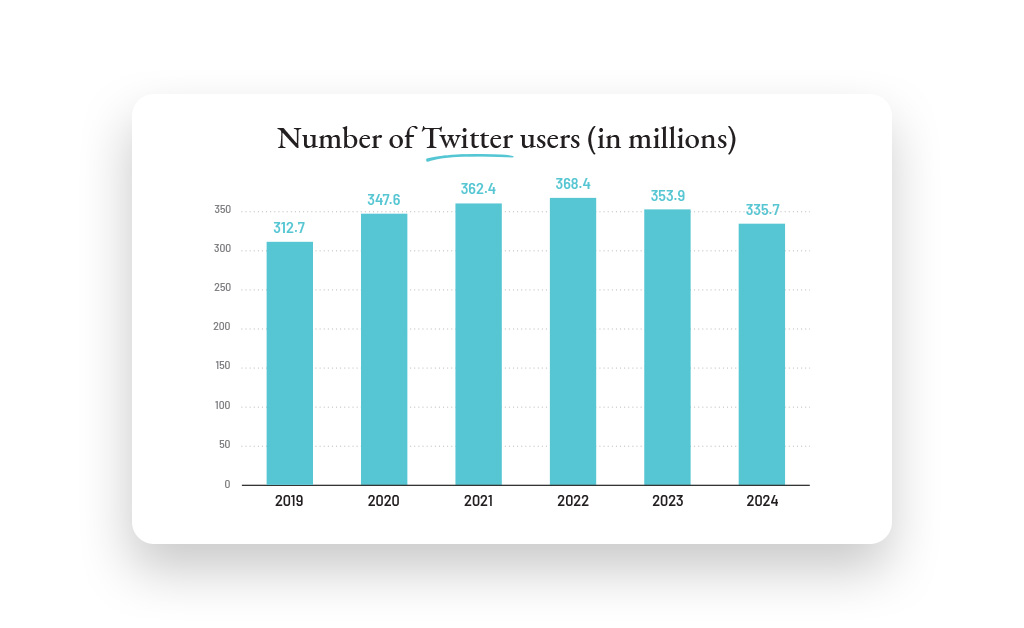
Twitter/X active daily users 2019-2024 (in millions). Source: Statista
So, objectively an unpopular and unsuccessful rebrand. But one that at least feels ‘on brand’ with its current identity.
Back on the topic of trends, is there a happy middle ground? Most brands inevitably find themselves somewhere in between. No company wants to be seen as out of touch — even if their audience is more traditionally-minded, so it’s important to keep an ear to the ground and stay conscious of changing trends as they emerge and fade around us. A company that was once completely on-trend may fade and become out-of-touch as time passes.
If you’re going to disrupt trends, it can be helpful to keep some familiar elements and not abandon everything at once, at the risk of appearing completely unfamiliar to the target audience. Investment decisions can be made in a split-second, on a subconscious level. So, while you might choose eye-grabbing colour to stand out from competitors, it can be useful to stick to other conventions like typical font choices or website imagery to ensure that connection is still made with your audience.
Sprinkling in trendy surface elements onto a foundation of a brand can be a solid approach. Minor refreshes might include expanding a colour palette to utilise new combinations, or to give a website a touch up with a new font choice.
A unique brand look takes more work, as you need to break assumptions and create new meaning in the mind of your audience. Rather than leveraging established associations, there needs to be a conscious effort to communicate and set your new look as the standard, through marketing campaigns to build familiarity, along with consistent brand story development to ensure that messaging aligns with the brand’s look and feel.
Okay, quick story time.
In 1999, Salesforce was launched and quickly gained recognition for its cloud-based CRM solutions and unique approach to software delivery. It wasn’t until the late 2000s that they started developing a genuine content-based strategy. This included formats like blog posts, instructive guides, white papers, and webinars.
This strategic shift played a significant role in cementing their position as a leader in CRM and cloud computing.
Contents:
Salesforce would go on to complement their content strategy with their annual Dreamforce conference, featuring seminars, workshops, and keynote speeches from industry leaders. Over the years, the event has become a content generation machine, providing a focal point for their audience. This, in turn, generates additional assets for engagement and outreach.
Salesforce isn’t the only example, of course. Hubspot, Adobe, and many other B2B companies have made content a key pillar of their marketing strategy.
A survey from the Content Marketing Institute shows that 88% of marketers have successfully reached their goals of creating brand awareness and building credibility through content.
Source: Content Marketing Institute
At its core, brand awareness refers to the level of familiarity that consumers have with a particular brand. This is measured by how well consumers can recognise the brand's logo, name, products, and other offerings.
However, true brand awareness means a prospect understands your brand's character, values, and offerings.
When considering new software, companies are more likely to choose a brand they recognise and associate with quality and reliability. The effect of familiarity makes brand awareness a critical first step in any content strategy.
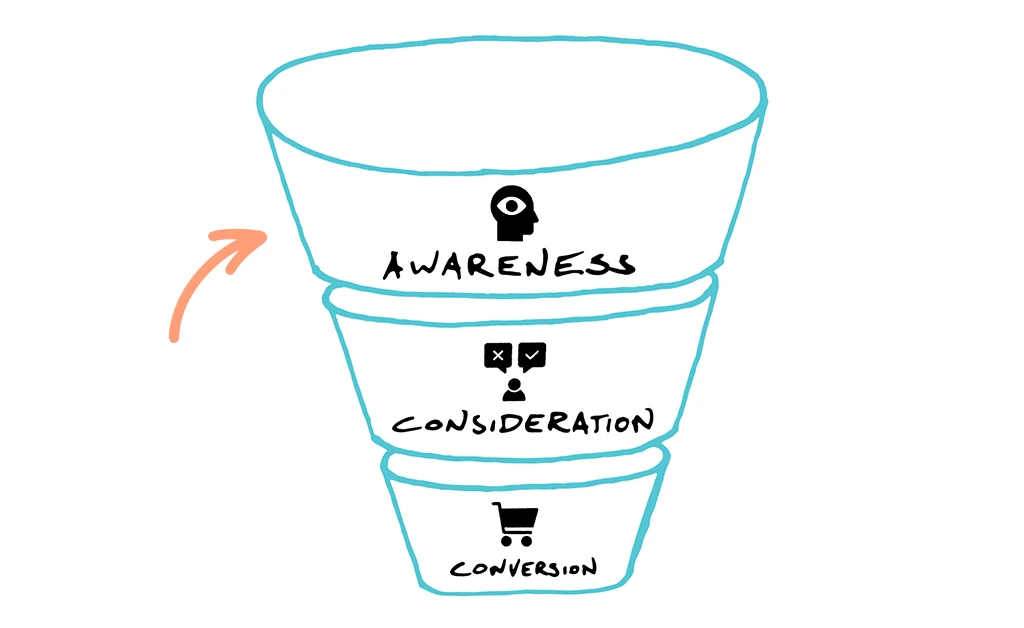
Brand awareness sits at the top of the marketing funnel. It's the initial phase where a business makes its first impression. This is where brands catch the eye of potential customers and begin to build a relationship. Think of a prospect scrolling through social media and pausing momentarily at a brand's post offering a potential solution to their needs; this is the start of the ‘awareness’ phase.
As potential customers move from awareness to consideration, they might start to shortlist their preferred options. This is even more likely when it comes to bigger purchases that require sign-off from multiple stakeholders within a company. Brands that build greater awareness are more likely to be considered because stakeholders feel more confident to give sign-off. For example, a business needing a cloud storage solution is more likely to consider a brand that’s shown relevant expertise in an article they’ve seen online, rather than a complete unknown.
Finally, in the conversion (aka purchase) phase, familiarity and trust built through consistent brand awareness can strongly influence consumer decisions. It's the reason why businesses will often end up choosing a brand they've already engaged with through other channels. For example, they might have previously viewed a webinar, online workshop, or downloaded a product guide.
In short, by including value-adding content as part of marketing strategies, brands can inform, educate and remain top-of-mind, paving the way for consideration and, ultimately, conversion.
Learn how TMP can help you build a successful B2B marketing strategy.
Brand awareness goes beyond recognition, of course. It offers both tangible and intangible benefits that can profoundly influence business outcomes, particularly in the B2B sector.
Content stands out as one of the most cost-effective methods for generating brand awareness, particularly when compared to traditional marketing channels. It's estimated that content marketing costs 62% less than traditional marketing and generates about three times as many leads.
Why’s that? For starters, paid ads are interruptive. Whether it’s a TV commercial during your favourite show or a sponsored post in your Instagram feed, ads get in the way of the content that audiences are actively trying to engage with. Yes, they serve to increase brand awareness. And yes, sometimes they’re funny or informative to some degree, but ultimately they’re obstacles that quickly become annoying and repetitive. This means audiences are more likely to tune them out, or in some cases, even resent certain brands for their incessant ads.
In contrast, content marketing aims to build positive brand association by creating content of value. While the purpose of traditional ads is to ‘sell’ you something in a short space of time, content marketing is a slower burn. But the content gives audiences a reason to seek it out, rather than something that gets in the way. Maybe it’s a seminar featuring knowledgeable speakers from the industry. If you sell a certain product, you could produce a how-to guide for optimising its use. It could be as simple as an informative blog post or step-by-step video.
If you can resist the urge to default to the ‘hard sell’ approach in this content, all the better. When you ‘bait-and-switch’ with content that purports to be useful and then serve users a thinly veiled ad, this undermines any trust you’re trying to build and people will quickly disengage. If you can serve a need for your audience by creating content that’s shareable and actually provides value in terms of the challenges they’re trying to solve, the brand recognition will come.
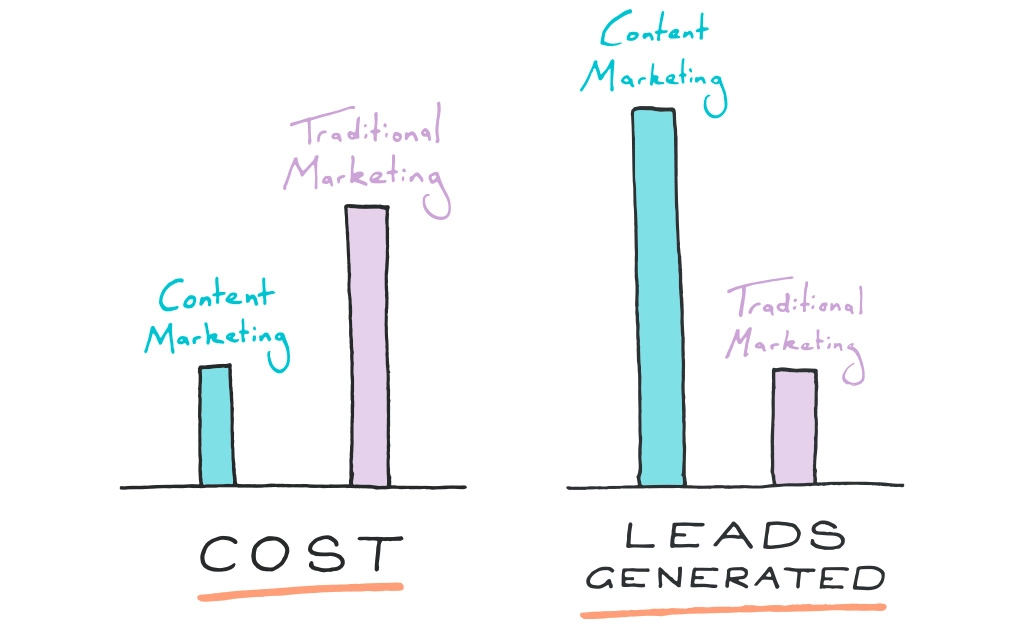
Unlike traditional advertising, which often requires significant investment for media space or airtime, branded content can be housed on company-owned channels at no cost. Creating digital content is generally less expensive than producing content for traditional media outlets like TV or radio, where production costs are significantly higher.
It’s worth considering the lifespan of useful content too. Once published, content can continue to engage and attract audiences over time, unlike a paid ad that stops generating returns as soon as the campaign ends. For example, a well-written blog post or whitepaper can continue to draw traffic and generate leads for years after its initial publication, offering an ongoing return on investment.
A single piece of content can also be repurposed across multiple channels, such as social media, email newsletters and so on, maximising its reach without additional cost.
Content marketing also supports SEO. Search engines favour high-quality content, which can improve a website’s ranking and visibility without the ongoing costs of pay-per-click (PPC) advertising.
Customers are much more likely to deal with brands who know what they’re talking about. Publishing insightful articles, industry reports, and expert commentary can establish your brand as a thought leader while addressing the needs and challenges of the target audience.
Salesforce and Canva are good at this. By regularly producing and sharing in-depth analyses, trends, and innovations in CRM and cloud computing, they showcase their deep industry knowledge and build their reputation as an authority in their respective sectors.
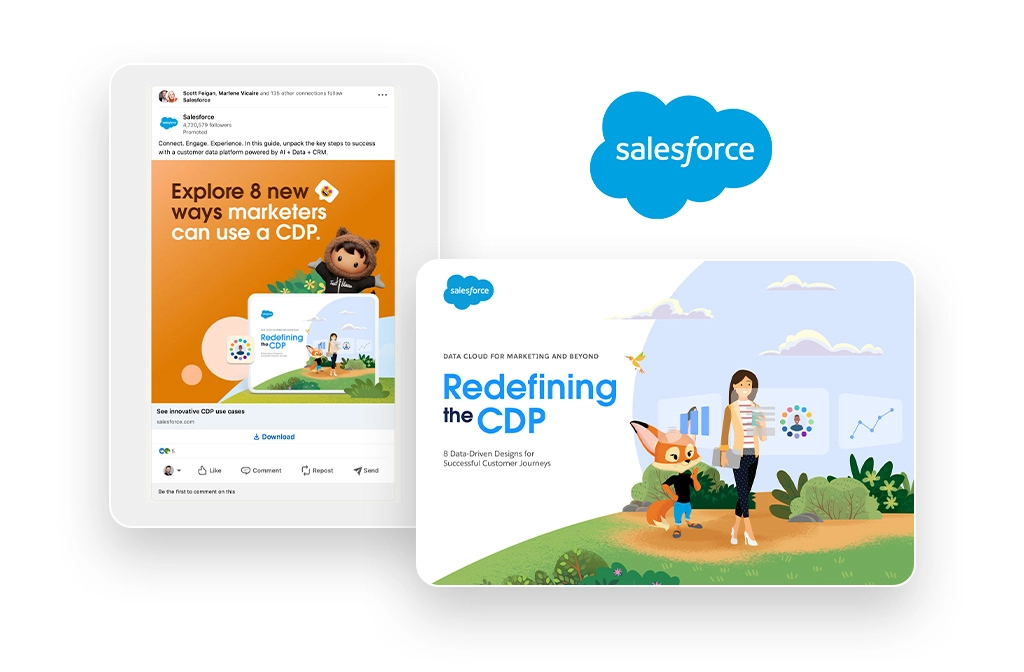
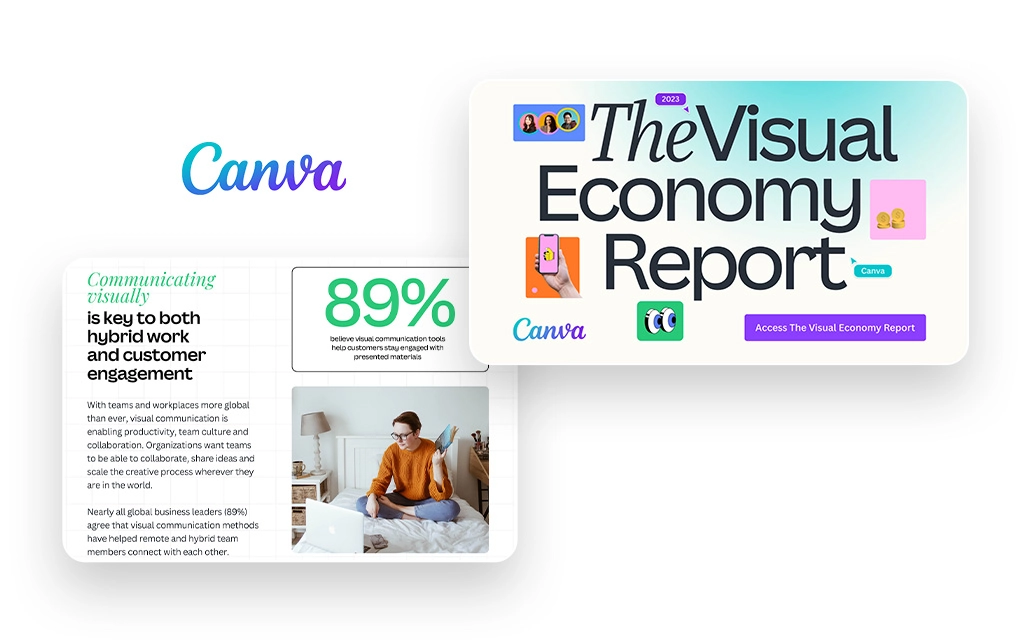
Sure, ‘storytelling’ can sound a little pretentious in a marketing context. But really all it means is using a narrative framework that resonates with the audience. We all prefer having things explained using real-world examples. Show, don’t tell – as they say. This can help create an emotional connection and make content more relatable.
SEO-driven content focuses on creating material that ranks well on search engines, enhancing brand discoverability for those seeking related information or solutions. By targeting specific keywords and addressing relevant topics, companies can attract organic traffic, thereby increasing brand visibility and authority. To learn more about how to effectively research content topics, check out our guide on content topic research.
Social media engagement is about actively interacting with audiences on various platforms (doing this yourself or with the help of your B2B marketing agency), sharing timely content, responding to queries, and fostering a community. This approach helps humanise a brand and keeps it top-of-mind.
Providing educational and how-to content positions a brand as helpful and knowledgeable in its field. This type of content often addresses common questions or challenges faced by the audience, establishing your brand as a go-to resource.
Case studies and client stories are a powerful tool to demonstrate how a brand's services or products can solve real business problems, which adds credibility to the company image.
Deloitte showcases its expertise and problem-solving capabilities through effective written and video case studies which include project insights and demonstrable client results.
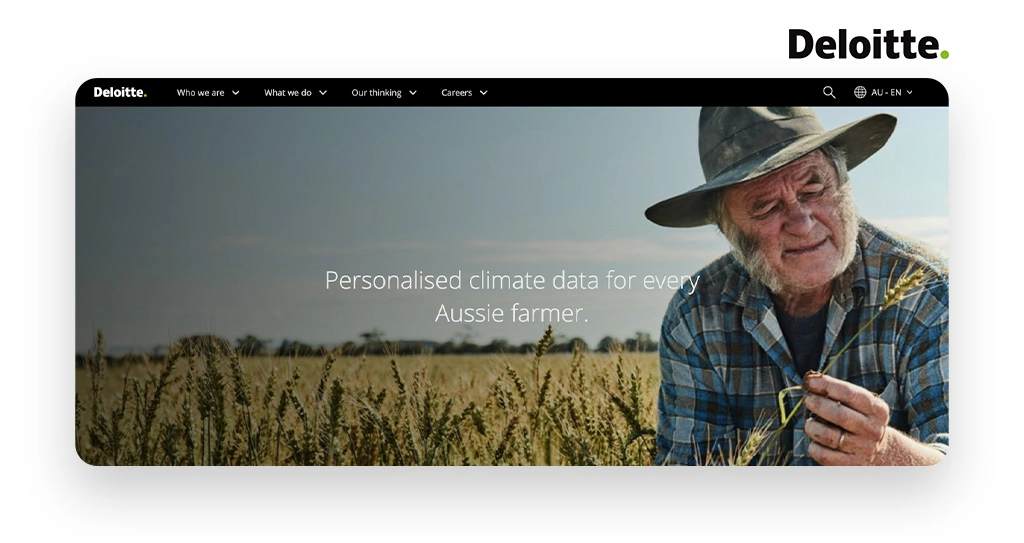
Marketers can develop user-generated content to create a sense of community and authenticity around the brand, as potential customers see real stories and experiences rather than just brand-driven narratives.
By encouraging travellers to share their Australian journey using specific hashtags, Tourism Australia leverages the power of user-generated content. The real stories and visuals, shared on Tourism Australia's platforms, serve as genuine, relatable endorsements that seamlessly leverage customers as brand advocates.
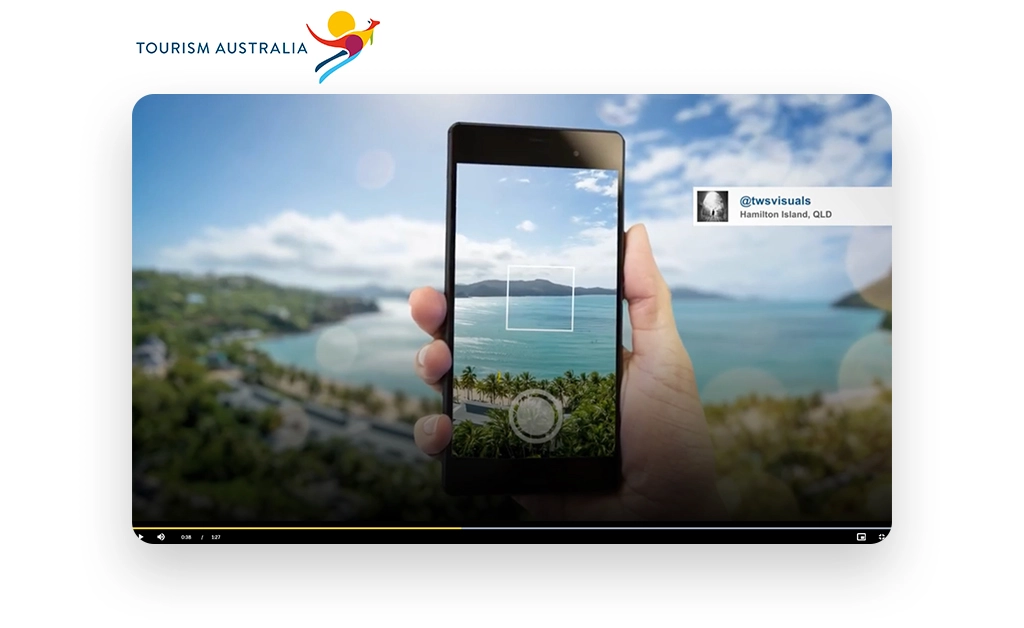
The significance of content’s ongoing role in nurturing leads is clear. With prospects’ behaviour increasingly influenced by the quality and relevance of the content they interact with, B2B companies must recognise that investing in content is a viable path to growth.
The brands that stay on top of these trends, while adapting and innovating their content strategies, will be the ones to secure higher brand visibility and loyalty in the years to come.
This requires an approach to developing content that’s strategic, engaging, aware of the opportunities offered by the latest technologies and aligned with the evolving preferences of their target audience.
Strategic B2B social media marketing is not just about having an account with a pretty feed that attracts a lot of likes. Nor is it about shoving your products down people’s throats. It’s about using social media strategically to build relationships with your prospects.
B2B social media marketing often falls into the trap of being devoid of personality, out of fear of not appearing ‘professional’ enough. But it’s important to remember you’re not communicating to a business—there’s a real person at the other end of your post you’re trying to reach, human to human.
One of the key differences between B2C and B2B marketing is that the sales cycle is usually much longer for us B2Bs than for B2Cs. We need to spend longer building and nurturing relationships with our prospects. Your sales team can be in contact with someone for a year or more before the sale goes through. If you think about your social media audience as that contact, what conversations would you like to have over the course of that year?
You could argue that building relationships through social media is even more important for B2B brands than for consumer brands.
Social media offers us a place to meet our prospects where they are. A smart B2B social media marketing plan will outline the strategies you’ll use to meet your business goals.
More than half the world is now on social media.
Worldwide, more than 2.7 billion people are on Facebook. More than a billion are on Instagram. LinkedIn has more than 675 million users. Closer to home, Australians spend an average of 1 hour and 47 minutes on social media each day, a figure that has been slowly increasing over the past 8 years.
B2B buyers research before making a purchasing decision and they use social media as part of that research. A LinkedIn study concluded that social media interactions influence 84% of C-level and VP-level buyers before they purchase a product or service.
By ignoring or playing down the importance of social media in our overall marketing plan, we’re handing our competitors the knife to carve off a great slice of pie for themselves.
Despite the prevailing cry of ‘be everywhere’, this is absolutely not true for B2B social media marketing.
B2B social media marketers can and should be far more discerning.
You don’t need to launch a TikTok account just because its popularity is rapidly rising. (Phew! Frankly, my cat’s not that interesting and who’s got time to learn how to dance this week?)
And you don’t have to use every new function of each platform you’re on. It’s OK to be on Instagram and not use Reels for your business.
Use our Customer Research Matrix to help you figure this out and create a clear picture of your ideal customer. When you have great clarity around your target audience, you’ll know where and how your brand should be on social media.
Just like any other business function, don’t bite off more than you can chew. As part of your marketing plan, consider which resources your business has that you can assign to manage your social media presence.
While LinkedIn, Medium, Twitter, Facebook and Instagram might be a good fit for your business, if you don’t have the resources and budget to maintain a professional social media presence, show up regularly across your chosen platforms and create fresh content, instead, focus your efforts on the top performing channels and do these well.
There needs to be a good reason for joining a social media channel that aligns to your marketing plan. A hastily set-up and soon-abandoned social profile does not reflect well on a business.
When people visit social media, they’re there to connect with others, be entertained, informed or inspired. They don’t visit their social media channels to be sold to.
Even if sales are your end game, keep in mind that you need to build relationships with people first.
This means your social media accounts should not be self-serving where you push out nothing but promotional posts dipped in sales messages. Otherwise, it will reflect badly on your brand. Promotional posts are fine, so long as they are in moderation and make sense in context.
You should look to educate, entertain, engage or inspire your target audience via your social posts.
Use a mix of social media posts to educate, entertain, engage and inspire
| Educate Share a link to a breaking news story or share an opinion on an industry topic. Share ‘how to’ tips for a common task in your industry. Turn one of your blog posts into multiple social media posts to help build your authority on a certain topic. | Entertain Share a funny meme that highlights a myth or stereotype about your industry. It doesn’t have to be one that you created. Share a video that’s relevant to your audience that you found entertaining or even amusing. Write a personal story that shares a funny experience that relates to your business. | Engage Ask your audience a question about a topic relevant to your industry. Add a poll to a post about a contentious topic in your industry and ask your audience to vote. Ask for help. Share a problem you’re having and ask your audience to solve it. | Inspire Share results another client has gained from working with you. Share a testimonial that outlines how you helped a client overcome a specific problem. Share statistics from your industry that show the positive side of an issue in your industry. |
To avoid appearing too salesy, keep in mind that you’re trying to build a relationship with prospects. B2B social media marketing is still B2-human communication. And because you’re communicating to a real human and not some faceless business brand, your social posts should feel more like a conversation than a billboard.
Your tone of voice should match your brand and position in the market. For example, if you make a utilitarian, no-frills products, then your tone of voice should come across in a similar way — no fuss, informative and functional. If you’re not selling high-end, complex software, don’t try to sound like you are.
If you’re selling data analytics or accounting services, you need to communicate to your prospects in a way that matches your brand and their expectations.
While you can (and should!) give your audience the kind of content they expect from you and in the way they expect it, it’s OK to be creative and try different approaches so long as you remain authentic to your brand. Standing out from your competitors can help your posts get noticed in your prospect’s cluttered feed.
Social media presents an opportunity for us to give our audience a peek behind the curtain and show the human side of our business. It’s where people can see the interesting things we’re working on and get to know us and the other people in our business, better. Consider passing the social media baton to your team members from time-to-time to help humanise your business. It’s a great way to show that there are real people and stories behind your brand. Plus, it keeps your content fresh.
Having a good marketing plan in place will set you up well to create an effective B2B social media strategy.
If you haven’t already identified your core brand pillars (those 4 or 5 top-level categories all your products and services fit under) then take the time to decide what those brand pillars will be. These are the key things you want your business to be known for.
Social media planning is all about working out what you’re going to say and when.
Plan topics and themes under your brand pillars. This will help you streamline your posts by staying focused on those core messages.
Think about important dates in your business—product launches, busy periods, seasonal influences, sales cycle predictions—and plan content to lead up to those events.
Prepare content in batches so you’re not having to scramble for fresh stuff each week. Batching social media posts saves a lot of time. Refer to the educate, entertain, engage, or inspire matrix to produce a good mix of content themes.
Use a social media scheduling tool to line up your posts in advance so they publish automatically across the week or month ahead. Then during the week, you’ll only need to set aside time to respond to comments to encourage more engagement and build those all-important relationships.
While B2B social media marketing might make you feel anxious about creating and executing a plan that perfectly balances a mix of post types that sound authentically like your brand while incorporating your end goal—sales— it doesn’t have to be overly complex.
We’ve prepared a DIY social media calendar to help you create a month’s worth of social media posts aligned to the topics you set under your brand pillars and to ensure you get the right mix of promotional and other post types.
Join the DIY Marketing Project for access to our calendar and plenty of other tools and resources to help you with your marketing.
The key to social media success for B2Bs is to use your authentic voice and let your personality show through while showcasing your knowledge and what you do best.
Keep an eye on your metrics to see which posts get more engagement and which posts don’t. Use these metrics to continually refine your social media calendar.
Use a spelling and grammar checker like Grammarly or ProWritingAid to avoid embarrassing typos that can make you look unprofessional and reflect poorly on your brand. You can hire a graphic designer to set you up with templates that reflect your visual brand and look great, or choose stock images and resize them yourself—we have resizing templates you can use on our DIY Marketing Project platform.
But perhaps the greatest tip is to remember that good B2B social media marketing is all about connecting human to human, not business to business. By showing the human side of your business and offering that personal touch, you’ll have a greater chance of bringing in enthusiastic customers who are on board with what you do.
If you’re a DIY marketer and need inspiration and guidelines to boost your marketing efforts, visit the DIY Marketing Project. You’ll find lots of resources and templates that will help you run your B2B social media marketing campaigns in less time and for better results.
Marketers often talk about sales, marketing and content funnels. Mastering your funnel is the key to business growth. But it’s not a case of one size fits all.
Read on for tips on designing your own funnel, and making sure each section plays its part.
You probably get the idea of a funnel as a broad term – it’s about the mindset of people as they move along a journey.

Many people enter into the top of the funnel (the wide part). The group gradually gets smaller, and their intentions stronger, as we progress towards the end of the funnel (the skinny part).
In the context of sales and marketing, this funnel’s journey generally starts when a decision-maker first starts thinking about a challenge, and ends when they make a purchase to fix that challenge. Some funnels follow the prospect a little bit beyond that purchase, through to when they start recommending their solution to others.
Why do you need to know your funnel?
Each funnel is subtly different depending on the industry and the department using it. Let’s look at the different types of sales and marketing funnels and how they work together.
This classic sales funnel might bring to mind Mad-Men-era print advertising, or Alec Baldwin’s character in the film Glengarry Glen Ross. It’s a good simple template to follow when selling pretty much anything, and a salesperson can apply face-to-face or digital tactics across the whole journey.

The idea here is to capture the prospect’s attention, and then be interesting enough to hold their attention while you explain the benefits and create some desire for your product. Then, give them the confidence to take action without fear of disappointment.
The marketing funnel follows roughly the same trajectory as the sales funnel – the only difference is that it was created by marketers, not salespeople. This means it naturally has a little more complexity and a few more moving parts.

This funnel is more focused on the mindset of the prospect than the action of the salesperson. It’s especially relevant in B2B marketing (what we do!), where sales journeys are significantly longer, take a lot more thought and involve many more people.
Here, the prospect has an awareness of their challenge, then weighs up potential solutions before converting into a customer. From there, you want to hold onto them to retain their lifetime value, and enable them as an advocate so they can do the selling for you.
Now we’re talking specifically about content marketing, and mapping the content you create across the buying journey. The content funnel closely mirrors the marketing funnel above, but simplifies it into three main sections:

This makes it easier for a content team to create pieces which span the whole buying journey.
You’ll notice the loyalty and advocacy stages from our marketing funnel don’t feature here. But that doesn’t mean you should forget about them. If you engage with your existing customers when creating content – for example, asking them what they’d like to see from your content, or coming to them for an interview – it reinforces their commitment to your business.
Your sales and marketing functions should work in harmony, with content as the fuel in the engine.
Create content for prospects at every stage of the funnel. That way you’ll have something for your sales team to take out to a meeting or send to a prospect whatever stage they’re at, and you’ll have plenty of ammunition to use for remarketing ads and email campaigns.
Good content comes from good communication. Open the channels between your content creators and customer-facing members of staff so that your content is directly informed by customer challenges and queries.
Taking your marketing – and your business – to the next level requires a bit of background work.
Scattershot approaches will work some of the time, but if you’re serious about building a brand that lasts, you need a brand story.
Your brand story holds the fundamental principles of why you do what you do. It tells anyone reading it who you are, what you stand for, what’s different about you, how you should sound in communication and what the most important things about you are.
We almost always include a brand story with new client projects. It’s amazing what comes out – our clients always discover new things about their own businesses.
It’s made up of five key components – business values, USP, brand voice and key marketing messages.
Let me take you through it.
Any business leader should watch Simon Sinek’s TED Talk, ‘How Great Leaders Inspire Action’. It’s a bit of a sacred text in the business world.
Simon’s idea is simple: people don’t buy what you do, they buy into why you do it.
Great leaders aren’t afraid to say what they think. To give a crap about changing the world (or at least their industry) for the better. Great brands are no different.
People buy from you because they like the journey you’re on and they want to ride shotgun. That’s why it’s so important to have your brand values nailed down, and communicate them to your audience whenever you get half a chance. They show what you truly stand for as a business, your non negotiables and form a foundation for your ‘why’.
Defining your unique selling proposition can be a tricky one for some brands to identify. Not because they aren’t doing great, unique stuff, but because sometimes it takes an outsider’s perspective.
Clients we work with are quick to cite aspects of the business that they think are unique, but often we find that it’s an aspect of the business that they hadn’t even given a second thought – for example, something in their manufacturing process, or an tech process they’ve created to save themselves some time.
There are plenty of bad value propositions out there. Often they’re the product of boardroom compromise, and say way too much without actually saying anything. But actually, this should be one of the most exciting parts of the brand story process. It’s the time when you put yourself in your audience’s shoes and ask: ‘What’s in it for me?’.
Your value proposition should answer a few key things:
The good news is that once you come up with this, it’s going to get plenty of airtime. Your value prop should form the basis of your primary messaging – for example, your website homepage. It should be on your business cards and even on the wall of your office.
Try creating your own – let me know how you go!
As a business scales up, it’s important to have some kind of record of your brand’s tone of voice. You’ll have different people from marketing, client services and support all speaking on behalf of the brand – not to mention any freelancers or suppliers you might bring in to support your growth.
So it’s essential that you have something down on paper that captures how your brand should communicate.
This can be as simple as three words, e.g. ‘creative, mature and charming’ – a couple of guidelines – e.g. ‘we talk straightforwardly and don’t use technical jargon’ – or a 20-page document full of specific dos and don’ts, depending on what kind of business you are and how much content you think you’ll be creating.
From our point of view, the more you can flesh this out, the better (our copywriters love detail). A strong brand voice will ensure you’re distinctive and consistent across your website, on social media, in your advertising and in your content marketing.
The final part of the brand story is to craft a set of ‘key marketing messages’. These are the essential statements that cover each of your main selling points. You can then come back to your library of marketing messages and pick the right one for the audience and the context you’re marketing in.
(You don’t have to reuse them word-for-word – but your key messages should be able to be used externally if needed.)
You should have several (we go for at least 5) per audience segment.
Here’s what makes for a good one:
These messages can form the basis for content you create, or work on their own in your marketing and advertising.
A cohesive foundation like this makes everything else easier:
It’ll also make it so much easier to engage (and get the best value from) a B2B marketing agency, should you choose to.
Just remember these steps:
Want some help? Get in touch. We’ve taken lots of clients through this process and we’d love to help you too.
Right now you might be looking at your brand assets – especially your website – and feeling like they haven’t evolved as quickly as your business has.
You might not have the budget right now to build a whole new website from the ground up, but you CAN make a few tweaks and improvements that will make your website feel fresher and help extend its life.
Here’s a quick runthrough of how to do a quick and basic website audit, including the main things to make sure your digital shopfront is doing its job.
With a few quick tweaks in your website’s back end, you can make a real difference to how your website appears in Google’s search results. Check each page to make sure your page titles & meta descriptions have been added, include the page’s target keyword and are the correct length.

If you use WordPress, we recommend downloading Yoast SEO plugin, which will help you edit those titles and descriptions easily and give you some handy tips for improving the SEO of each of your website pages.
And If you’re wondering why your website has disappeared completely from Google, it might be because of security issues or a virus. Google’s help pages also have plenty of good tips which will help you improve Google’s ability to find and crawl your site.
Take a look at your homepage copy (that is, the words on the screen) from an outside perspective. If you can’t do that (or if you wrote the words in the first place), ask a trusted colleague or contact to have a look for you and provide some honest feedback. If you have a good relationship with some of your customers, even better – get them to review your website from a copy perspective.
Does it represent your business in its current form? Is it too wordy or vague? Sometimes all that’s needed is a new line in your homepage banner.
Make sure your copy is ‘customer-centric’. This means making sure you don’t fall into the trap of talking about yourself all the time, rather than what you can do for your customer. Test this by counting the amount of times you say ‘you’, and making sure it’s more than the amount of times you say ‘we’.
Finally, comb through your website and make sure the copy is correct and free of spelling and grammar mistakes. This might seem overkill but it’s better to be safe than sorry – one tiny mistake and many will immediately write you off.
As your business focus evolves, your website should adapt to reflect this as well. If you no longer service certain industries, get them off your website or swap them for industries you’re looking to enter.
Give your XML sitemap a quick audit (you may need someone technical to help with this) to make sure you haven’t got any ‘orphan’ pages that aren’t linked to from your site.
It’s also a good idea to check the ‘flow’ of your website – you might be able to access every page from the homepage, but are the rest of your pages still accessible once you’ve made a few clicks?
Take another look through your website, this time focusing on just the imagery. Are your staff shots or stock photos looking a little “intimate” by today’s socially-distanced standards?
Update your photography to reflect a new working environment – maybe less handshakes – and also to capture the latest visual and photography trends. Having visually appealing, modern photography subconsciously communicates that you have a good eye for detail and you know your stuff.
Stay away from tacky, cliched stock images – use something like Unsplash instead.
Your ‘Call to Action’ (CTA) is arguably the most important point on the page. It’s the mechanism through which your customer carries out the action you want them to take – for example, the ‘buy now’ button, or the ‘subscribe to newsletter’ form.
Check all your pages to make sure there’s a single and clear call to action on each page. Ask yourself, “What do I want my reader to do on this page?”. Then make it easier than falling off a log.
(To be clear, you can absolutely have more than one button on each page – but keep them similar for clarity. your audience should know exactly what you want them to do.)
Don’t forget your ‘thankyou pages’ – the messages or pages people see after they click your CTA. People tend to just forget about them. We’ve seen a lot of outdated COVID-related messages, and even some Christmas closure messages on thank you pages lately!
Is your marketing a bit stale? Feel like you’ve hit a plateau? You might have heard about growth hacking from the startup world, but actually any kind of business can do some marketing growth hacking of their own to see results without huge spend.
For your average B2B business, your best measure of growth on the marketing side is your sales pipeline. So our tips here are all about engaging new leads, re-engaging old ones and making sure they slide smoothly down your marketing and sales funnel.
Here are five marketing growth hacks you can start using straight away to unlock more leads and start having better conversations.
LinkedIn Sales Navigator is a great tool for finding perfect prospects and engaging with them.
Use the tool’s in-depth search functionality to find who you’re looking for. You can search by company size, content keywords, even what school they went to – check out the full list here.
Then you can create lead lists (which only you can see) for specific segments – perfect if you service a few different industries or business sizes.
Don’t just rush in with a sales message – follow what they post and engage with their content. Not only is it a more personable approach, but you might be able to answer a few of your initial sales questions just by what they’re posting. You can build out a clear picture of their personality and their challenges before you come in with a pitch.
Yes, there’s lots of noise distracting from the signal on Twitter, but lots of relevant conversations happen there, and certain industries (like tech) are very active. There’s also a certain kind of discourse that happens on Twitter that you won’t find on any other B2B social media community.
Use hashtags and location search to find people talking about the topics you’re interested in. You can use Twitter’s Lists functionality to keep track of prospects, but keep in mind that every Twitter user can see which lists they’re on.
Once you’ve found your target audience, start getting involved in conversations. If you have some crossover from your LinkedIn list, engage with them on Twitter too – just make sure to do it in a manner that’s appropriate for the platform. The same works vice versa – often you’ll want to bring Twitter leads over to LinkedIn for a more work-focussed conversation.
When you find a trending topic, the next step is to start capitalising on that buzz by setting up a Google Ads campaign to direct traffic to your website (use Google Keyword Planner to narrow in on the specific keywords – the below example is a keyword search for “marketing growth hack”).

You need to send that traffic to a page that’s relevant to the topic and provides some value – for example, sending leads from a specific industry to your industry-specific website page. If you don’t already have one, write and publish a blog on the topic. Otherwise, the traffic will bounce and you’ll just be wasting your money.
Here’s an example from our perspective: if a topic was trending about the rise in small B2B marketing agencies, we could write a blog about how we only focus on B2B (and why), and then set up a compelling Google Ads campaign to direct traffic to it.
If you already have a library of blogs that perform well, you don’t need to get distracted by the need to be pushing out heaps of new stuff. You can add value to your existing blogs by adding in ‘content upgrades’.
This is content that’s more in-depth than the blog but still the same topic – for example, a research report or an infographic.
Put a link to this upgraded content on the blog, but behind a form. This is a great technique to combine with your Google Ads from point four.
Right now you might re-engage with an old contact if you happen to remember them, or you have a new product or service to pitch. But as you grow, you should have a system in place for re-engaging with old prospects.
You can set up an email automation through your CRM software – but there’s nothing wrong with an old-fashioned phone call or email as well. Just make sure you have a trigger which will notify you when it’s time to get in touch.
These prospects could be proposals you didn’t win or leads that fell quiet… there’ll be a lot of them, and it might look like an intimidating list – but remember, they showed interest in your business for a reason. If you have a shiny new piece of content (or you’ve recently updated an older one 😉) you have a perfect reason to reach out.
Now you’re ready to start your own growth hacking campaign with our tried and tested marketing growth hacks. With these techniques you can break that plateau and get your message out to a whole new audience.
Just make sure you’ve refined that message and your proposition is crystal clear before you start – you wouldn’t want to waste the opportunities about to come your way!
Would you rely on ONE supplier for your entire business model? 😬
I’m guessing probably not…
But many growing B2B businesses are doing just that with their digital marketing tactics. They’re concentrating on Facebook as their main channel for connecting and communicating with customers, and neglecting the rest.
As we’ve seen recently, that tap can be turned off in an instant🚰 and there’s not much you can do about it.
So we’ve been thinking about a few ways you can keep the conversation flowing without relying totally on Facebook – or LinkedIn, or Twitter or Instagram or even TikTok for that matter.
Engaged and targeted email lists are absolute gold dust for marketers. With a bit of time, effort and budget you can segment the contacts in your email list enabling the creation of really targeted email campaigns.
A huge benefit with email marketing is that you own the data. You can export your (opted-in) email list and take it to another platform if your email provider bumps up your rates, shuts down or you just decide you don’t want to use them anymore.
And thirdly, you have direct access to your subscribers’ inbox – often the first place people head when they start their day.
Sending out regular, insightful and valuable emails to your subscribers is a great way to build rapport over time. Some email marketers even monetise their newsletter by charging people to receive a ‘premium feed’ on a platform like Substack.
Another cost-effective way to build an audience, writing articles for a blog is the foundation of most effective content strategies. Once you get the hang of getting your thoughts into words, your articles can give your audience a window into your thoughts and opinions on industry topics, as well as an insight into the culture of your business – a great way for them to decide whether they want to partner with you.
This is especially important in B2B marketing, where sales cycles are often longer and there is a greater emphasis on service and knowledge.
Best of all, a blog is multiple pieces of content just waiting to be set free. Grab the best quotes and turn them into images for Instagram, publish a section on Facebook and LinkedIn or do a quick video summing up what your piece is about – all linking back to your own website where the blog is hosted. Once people are there, you can invite them to sign up to your email list, either by offering a free piece of content or the chance to join your newsletter.
You can capture their details using a form like this:
This is an example of an embedded form. Offer your readers a free download in exchange for their email address. Make sure it’s a high-value piece of content to make it worth their while!
It’s one thing to write a blog, but you also have to promote it. Many content experts say that content marketing is 20% creation and 80% promotion! Make sure you have a thorough marketing plan in place to drive traffic to your blog articles.
If you’re less ‘wordy’ and more of a talker, consider starting your own podcast. This is a popular content format right now, so beware of jumping in just for the sake of it. But if you’re a compelling speaker and you have the means to record and edit audio, it should definitely be on your consideration list.
If you’re wary of just adding another podcast to the pile, remember you don’t have to do the same thing everyone else is doing. Mix up the format – if everyone is doing 30min interviews with industry leaders, consider doing a daily five-minute show that tackles one specific challenge. If you have a network of interesting contacts, try to get them involved as a guest or co-host. If there’s something about your work that’s interesting or quirky, use it – for instance, you could record a quick episode in the car while you’re personally delivering a customer order, if that’s your point of difference.
You don’t need to be restricted to just Apple or Spotify – you can embed the audio on your blog, send it out via your email newsletter and cut up the audio into bite-sized chunks for social media. You can even monetise your podcast via Patreon if it really takes off.
Search Engine Optimisation (SEO) is closely connected to your blog and your website. Making sure your website is well-optimised for search engine robots is a fruitful long-term strategy.
There are two aspects to SEO – on-page and off-page. Let’s look at both quickly.
On-page SEO:
On-page SEO refers to the SEO tactics that are on your website – things that you can actively control.
It includes things like:
On-page SEO isn’t just for Google – it’s better for your customers too. Having a website that’s easy to use and keeps prospects engaged means people will spend more time on your site learning about your business, which Google will favour.
Go for quality over quick fixes. Google’s bots are getting more and more sophisticated, so the old “SEO hacks” don’t work anymore. The best thing to do is make decisions that are best for your end user, and will keep them engaged on your site for as long as possible.
Your ‘technical SEO’ also has to be solid. Double-check that:
Off-page SEO:
Off-page SEO is a little trickier, and harder to control. It’s about your brand’s reputation and authority in your industry.
The biggest off-page SEO tactic is link building. This is where you have other reputable brands linking back to your website – and another reason why it’s so handy to have a good selection of blog articles for other sites to link to.
The ‘holy grail’ of link building is to get a link from a .gov or .edu link, because you can’t just go out and buy one of those domains. You have to earn those links – so that means you need someone within your business who can reach out to these websites and build a natural relationship with them that leads to linking between sites.
Additionally, linking TO those high authority sites is a good idea, because Google sees this as you being more reputable. For example, if you’re talking about crime rates, linking to a .gov site gives you more authority on the subject, as you’re citing official sources.
You can (and should) also do a lot of internal link building – that is, linking between blogs and pages on your own website. If you’re writing a blog and you reference something you’ve written about before, link to it! This tells Google that your site is an expert about one key theme, and all your content is connected.
We’re a big fan of creating mutually beneficial relationships with other businesses that have a similar audience as you but aren’t competitors. You can share the marketing load while both getting the benefits!
Reach out to other businesses and ask if they’d be interested in co-creating some content or doing some joint marketing. What you do will vary depending on your industry and business size, but here are a few ideas:
Be sure to use the detail from tactics 1-4 to squeeze the most value out of any joint marketing you do.
And whichever of these tactics you decide to pursue, here’s your golden rule: Be across as many channels as is practical for your time and budget, but make sure a good portion of that activity is on channels you own.
Your company blog is one of your greatest untapped resources for engagement and thought leadership. That’s why every marketer should have competent blogging skills in their armoury.
There are so many benefits: they’re free to publish, you control the environment completely (e.g. no limits on length or images) and best of all, you’re not at the mercy of a changing social media algorithm.
But you might sometimes find it tough to flesh out your initial blog ideas into full articles. Don’t stress – it happens even to the best writers. To get the information out of your head and onto the page, you don’t have to reinvent the wheel – just rely on a solid structure to arrange your thoughts.
There are all kinds of structures you can use depending on what kind of information you’re trying to get across. Some are more complex than others, but in this piece I’m showing you how to write a blog post using a nice, simple framework that will draw out your best insights in a way that’s easy for your audience to understand.
Here’s a tried and tested framework any B2B blogging beginner can use for turning topics from your content strategy into fully-fledged articles that grab attention and build your audience.
Here’s where you need to grab the reader’s attention and explain exactly what they’ll get. The biggest headline mistake I see is people trying to fit a complex idea (like a metaphor) from their article into the headline.
Cryptic headlines generally don’t work in a B2B business blogging context. Make a promise instead.
I normally start with a ‘working’ headline in mind which I came up with when first researching the topic. I’ll rarely keep that one in the final article. As I write the piece, I copy and paste any nice lines and paste them up top under the original headline. By the end, I’ve got a list to choose from and I’ll probably add a couple more. Then I’ll test them out or ask for a second opinion.
You don’t always need to start from scratch – you’ll save a load of time if you have a few ‘fallback’ headline formulas. There are many specialist copywriting blogs which will give you a list of proven headlines you can use. As an Easter egg, I’ve taken one from this article for this article’s headline – can you spot it?
And don’t forget to include your SEO keyword! Not only is it good for SEO (of course), it also keeps the headline focused on the reason you’re writing the post in the first place. Keyword research mimics the queries of your audience, so you’ll be speaking in terms they understand.
Here’s mine so you can see my process in this article.

Your first paragraph should do three things:
- Introduce your topic
First, introduce the topic and set the scene. Your knowledge of your audience is important here – ask yourself what they already know about this topic and why they’re looking for more information. Meet them there. Use statistics if you’re talking about a common topic (be sure to reference where they’re from).
Next, raise the stakes. If there’s no reason to act – and act now – you’ll struggle to get people reading through your blog. In other words, why do they need to take action? And what happens if they don’t?
Be explicit about who you’re writing for. Go back to my introduction up top. You’ll notice that I said that these are tips that ‘any B2B blogging beginner can use’. I want my audience (people who work in B2B businesses who know they should be writing blogs but don’t know where to start) to feel comfortable reading this, and know that it’s going to give them some information they can actually use.
To finish off your introduction, explain to the reader in simple terms what they’re about to see and learn, focusing on the benefits (I’ve promised tips that will help you grab attention and build your audience).
Include your SEO keyword at least once in the introduction.
This is the main part of your article, and can be the most intimidating. Many people wondering how to write a blog post feel pressured to tell the ‘perfect’ story here. Leave that to the novelists and master the art of subheadings.
(If you’re looking for the easiest and most effective way to write a blog, this is it.)
Work through your points or arguments one at a time, using subheadings to define each separate thought (like I’ve done throughout this piece, with each section of your article under a different subheading).
You can add numbers to these subheadings to create a listicle, or leave them off to be more of a how-to guide (how I’ve styled this one).
Include your SEO keyword a few times throughout the body and in your subheadings if possible. Make sure it sounds natural – don’t just stuff them in for the sake of it.
One of the most common pieces of writing advice is “write first, edit later.” This might sound obvious, but what it’s trying to say is don’t get in your own way while you’re writing your first draft. It doesn’t have to read well or look pretty.
Write it first without engaging your editing brain (stay away from the backspace key), and look over the whole thing later when you’re in a different mindset. That’s when you can add in some structure and carve out a piece that flows nicely from start to finish.
End your post confidently. A neat writer’s trick is to call back something from your introduction for a satisfying conclusion. In the introduction of this article, I told you that your business’ blog is one of your greatest untapped marketing resources – so for my conclusion, I might say something like:
End with a Call To Action (CTA). Basically you’re telling your reader what to do next. Don’t give them three options – give them one compelling click to make.
Here’s mine: Now that I’ve shown you how to write a blog post like a pro, you can move on to nailing the rest of your marketing! There are more than 100 walkthroughs, step-by-step guides and templates available for unlimited use at the DIY Marketing Project, covering the basics (and beyond) of things like email marketing, graphic design, search engine optimisation, social media and managing your website. Head there and take a look!
Once you’ve mastered the basic blog post you can move up to more comprehensive posts (the kind of thing we describe as ‘pillar’ content).
Here are a few things you can add to take your blogging to the next level:
Happy writing! Don’t forget to visit the DIY Marketing Project to download all of the templates we use for our everyday work (including this basic blog structure guide in simplified PDF).